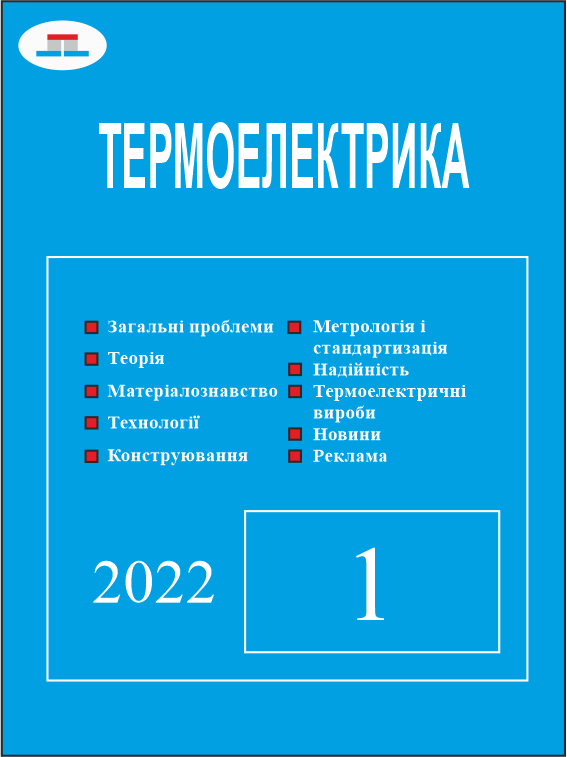Підвищення чутливості комп’ютерно-інтегрованих тепловізорів в дослідженнях термоелектричних явищ та дистанційних спостереженнях
DOI:
https://doi.org/10.63527/1607-8829-2022-1-64-81Ключові слова:
: поляриметричні тепловізори, вектори Стокса, поляризатор, чверть-хвильова пластинкаАнотація
Робота присвячена обґрунтуванню вибору поляризаційних оптичних елементів для тепловізійних дистанційних спостережень та вимірювань. Виконано порівняльний аналіз основних методів отримання поляризаційних зображень: з допомогою обертання поляризатора, обертання фазової пластинки і з використанням комбінованих матричних приймачів інфрачервоного випромінювання з мікро поляризаторами. Для аналізу використано спрощені математичні моделі перетворення сигналів в основних оптичних елементах поляриметричних тепловізорів – лінійних поляризаторах та фазових (чверть-хвильових) пластинках. Показана перевага дротяних поляризаторів порівняно з поляризаторами на основі відбивання. Також обґрунтовано, що серед різних фізичних ефектів, що викликають фазові затримки - подвійне променезаломлення, повне внутрішнє відбивання і відбивання випромінювання на межі повітря-метал, дифракція на дротяній дифракційній ґратці – найбільш прийнятним є використання останнього ефекту.
The work is devoted to the substantiation of the choice of optical polarizing elements for thermal imaging remote observations and measurements. A comparative analysis of the main methods of obtaining polarization images was performed, namely using polarizer rotation, phase plate rotation, and using combined infrared matrix receivers with micro polarizers. Simplified mathematical models of signal transformation in the main optical elements of polarimetric thermal imagers – linear polarizers and phase (quarter-wave) plates - were used for the analysis. The advantage of wire polarizers compared to polarizers based on reflection is shown. It is also substantiated that among the various physical effects causing phase delays – birefringence, total internal reflection and reflection of radiation at the air-metal interface, diffraction on a wire diffraction grating – the use of the latter effect is most acceptable.
Посилання
Anatychuk L.I. (2020). Efficiency criterion of thermoelectric energy converters using waste heat. J.Thermoelectricity, 4, 59-63.
Anatychuk L.I., Havryliuk M.V., Lysko V.V. (2021). Automation and computerization of processes of measuring thermoelectric parameters of materials forming part of generator and cooling thermoelectric modules. J.Thermoelectricity, 3, 63-70.
Vollmer Michael and Mollman Klaus-Peter (2018). Infrared thermal imaging. Fundamentals, research and applications. Second Ed. Wiley – VCH, Weinheim, Germany.
Tooley R. D. (1990). Man-made target detection using infrared polarization. Polarization considerations for optical systems II. – International Society for Optics and Photonics, 1166, 52-60.
Zhang Y., Shi Z.G., Qiu T.W. (2017). Infrared small target detection method based on decomposition of polarization information. Journal of Electronic Imaging, l 33004, №. 1.
Tymchik G.S., Kolobrodov V. H., Mykytenko V. I., Sokol B.V. (2020).Temperature resolution of computer-integrated polarization thermal imager. J. Thermoelectricity, 4, 22-37.
Kaplan Herbert (2007). Practical applications of infrared thermal sensing and imaging equipment. 3rd ed. SPIE Press (Washington).
Yang Bin, Wu Taixia, Chen Wei, Li Yanfei, Knjazhihin Yuri, et al. (2017). Polarization remote sensing physical mechanism, key methods and application. The International Archives of the Photogrammetry, Remote Sensing and Spatial Information Sciences. Wuhan, China, XLII-2/W7, рр. 956 - 960.
Gurton K.P., Yuffa A.J., Videen G.W. (2014). Enhanced facial recognition for thermal imagery using polarimetric imaging. Optical Society of America, 39 (13), 3857–3859.
Gurton K.P., Felton M. (2012). Remote detection of buried land-mines and IEDs using LWIR polarimetric imaging. OSA, 20 (20), 22344 – 22359.
Russell A. Chipman, Lam Wai-Sze Tiffany, Garam Young (2019). Polarized light and optical systems. Taylor & Francis Group, LLC.
Kolobrodov, V. G. (2020). Computer modeling technologies of optical system of polarizing thermal imager. Visnyk NTUU KPI Seriia - Radiotekhnika Radioaparatobuduvannia, (83), pp 69–74. doi: 10.20535/RADAP.2020.83.69-74.
Sun Zunyi, Jin Weiqi, Kang Guoguo, Li Li, Yang Jianguo (2022). A temperature-controlled mid- wave infrared polarization radiation source with adjustable degree of linear polarization. Measurement, Volume 196, 111210. Doi.org/10.1016/j.measurement.2022.111210.
Peterson J., Jensen G. L., Kristi J. A., and Shaw J.A. (2000). Polarimetric imaging using continuously spinning polarizer element. Proc. SPIE, 4133, 292-300.
Goldstein D.H. (2011). Polarized Light. Third edition. CRC Press is an imprint of Taylor & Francis Group. London New York.
Kemme Shanalyn A. (2006). Micropolarizing device for long wavelength infrared polarization imaging. Sandia National Laboratories. Albuquerque, New Mexico (USA).
Yamada Itsunari, Akiyama Tsuoshi. (2019). Infrared wire-grid polarizer with an ultrathin photoimprinted polymer film. Optical Engineering, 58(5), 057104, doi: 10.1117/1.OE.58.5.057104.
Kolobrodov V.G., Mykytenko V.I., Tymchyk G.S. (2020). Polarization model of thermal contrast observation objects. J.Thermoelectricity, 1, 36–49.
Born M., Wolf E. Principles of optics. 7th ed. Cambridge University Press.
Wire grid (reflective) polarizers. Retrieved from https://www.edmundoptics.com/c/wire-grid-reflective-polarizers/1337.
Globa L., Dovgiy S., Kopiika O. and Kozlov O. (2021). Approach to building uniform information platform for the national automated ecological information and analytical system, In: CEUR Workshop Proceedings, 3021, 53–65.
Globa L., Dovgiy S., Kopiika O. and Kozlov O. Approach to uniform platform development for the ecology digital environment of Ukraine. Book: Progress in Advanced Information and Communication Technology and Systems. 83–100 DOI: 10.1007/978-3-031-16368-5




